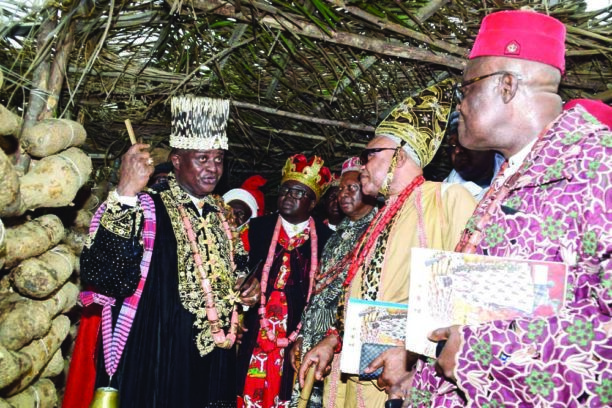Every ethnic group has a culture or tradition for which it is known. The Okon-Esaa, or ‘Yam Title Festival’, is one of such cultures which form the identity of Eleme people in Rivers State. Unfortunately, the last time this festival was celebrated was in 1975 – some 44 years ago!
His Royal Highness, Appolus Chu (left) conducting guests and indigenes round during a tour of his impressive yam barns.
Now, the good news is that the long-forgotten Okon-Esaa has been revived by the paramount ruler of Okori, the Egbere Emere Okori I of Eleme Kingdom, His Royal Highness King Appolus Chu.
Failure to observe the Okon-Esaa for so long had raised concerns over the years. It was therefore excitement and funfair when the paramount ruler of Okori facilitated the return of this noble but nearly extinct tradition. No wonder he is being held in high esteem by his people.
So, for the first time in 44 years, the people of Eleme Kingdom witnessed the age- long tradition – a custom initiated by their forefathers to help people embrace farming and in return be celebrated for being industrious and successful. This exciting cultural event held in Eleme local government of Rivers State drew traditional rulers, politicians, and friends from across the country. Appolus Chu, who accomplished this by planting, harvesting and storing the largest number of yams in his barn, was honored with the highest level of yam title: “A-Chu Ette Esaa”, given to the man that has the highest number of tubers of yam in the land. Farm work is symbolic in Eleme culture and tradition. A man is fit to marry a girl only if the parents of the girl see evidence that the man can take care of their daughter and her children. The strength he displays in clearing the farmland, planting and harvesting the yams is closely monitored. A man must therefore be industrious. This is how important the Okon-Esaa Festival is.
There are four levels of Okon-Esaa. A-Chu is the first level. This is a display of 21 tubers of yams on a yam barn in 100 places, bringing the total numbers of yams to 2,100 in a barn, traditionally called O-gun. This is what makes up the first title, A-Chu.
The A-Chu yam title is highly celebrated as the successful farmer bags a chieftaincy title – a reward for hard work. As part of the ceremony, the celebrant is made to climb the symbolic traditional Hill, Epee cha ebo ekpo, an act which signifies that he has been elevated above the level of an ordinary citizen into the class of title holders by dint of hard work. Other titles in-between A-Chu in sequence include Obo, Obere Obo, Otaa Obo, and the highest, A-Chu Ette Esaa. To earn the A-Chu Ette Esaa title, a man must have 42,000 tubers of yams in his barn. His HRH Appolus Chu has successfully attained this feat and it was celebrated in grand style during a ceremony that culminated in his slaughtering of a bull.
Chu, who performed the official slaughtering of the bull was later presented with gift items from family members, friends, in-laws and well-wishers who came from far and near bearing gifts to thank the celebrant for honoring and elevating them in the society, because the honor associated with the title is shared by his family members and those related to him in one way or the other.
Another highpoint of the festival was the tour of the yam barns of the paramount ruler containing the 42,000 tubers of yams. Chu is the first Eleme son to attain the A-Chu Ette Esaa within a short period of time, a feat that normally takes about 20 years to accomplish.
“What HRH Appolus Chu has done today is unheard of in the history of Eleme. This is the first time in the annals of Eleme that anyone would be taking all the Okon-Esaa titles at once. It’s a feat that ordinarily would have taken at least 20 years to accomplish. But this illustrious son of Eleme has done it at once,” said a participant.
The ceremony for A-Chu Ette Esaa title performed in front of the yam barn (Nsi Ogun) under a small hut roofed with palm fronds (Ola) had the celebrant dressed gallantly in richly adorned long attire, a hat and a bell tied to his waist with a string of cowpea-like instruments hanging from one of his shoulders down to his knee. He also had a small traditional musical instrument, the gong, with a stick to play it. He walked majestically in a procession before the people accompanied by various title holders in the land. The climax of the ceremony was the killing of a bull by the celebrant.
Speaking on the significance of the Okon-Esaa Festival, Chu said: “Anyone that loses his culture has automatically lost his identity. And when you have lost your identity, you are as good as a stranger in your own land.”
The festival was therefore a parameter set by the forefathers for measuring hard work, said Chu. It is a celebration of hard work, industry and success among the people of Eleme.
“The number of yam a person was able to display in his barn was indicative of his success, worth and value to the community. Our forefathers instituted this festival as a means of encouraging the youths to channel their energy into farm work. Accumulated energy needs to be expended positively,” he remarked.
One of the reasons for the high rate of criminality in our society today, he said, is the fact that young people have so much accumulated energy and just like water which must find it course, such accumulated energy ends up being expended on anti-social activities. He said another reason their forefathers instituted the festival and attendant titles was to encourage healthy competition among the people.
“No society can grow without healthy competitions. In the olden days, those who attained these titles were revered as stakeholders in the community. They, along with the king and the elders, were the only ones entitled to walk with walking sticks. So the rights and privileges enjoyed by the title holders served as a motivation for others to work hard and aspire towards such titles.”
The paramount ruler believes that Okon-Esaa, generally, will encourage people, especially the youths to invest their energy into farming rather than engage in anti-social activities: “I observe that a lot of our youths are discharging their energy in the wrong direction by engaging in cultism and causing restiveness in the community. So I had to sit down and review what our forefathers had done in the past. I concluded that such culture was a brilliant one because when you engage in farming and do all the farming exercise for the day; by the time you walk back home you are tired and exhausted. All you want is to bath, eat and take a rest for the day so that you can go back to work the next day. With such schedule, you won’t have the time to get involved in nefarious activities.”







